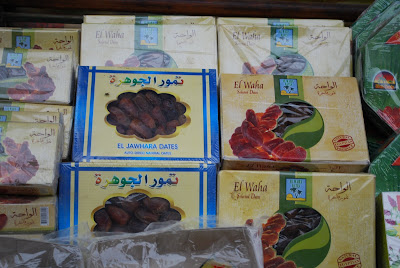
The Giza pyramids are faintly visible at the left corner of this picture.
After seeing the Mohammad Ali mosque at the Citadel, we exited in the back to a big viewing area. We can see the whole of Cairo and as far as the Giza pyramids. It was an amazing view to see the 'mud' colored buildings of Cairo and the oasis that is Giza in the far horizon. Among the palm trees of the oasis, the pyramids are visible. It was surreal. All my life, I've heard of songs, seen pictures and read about them and here am I and there they are, right in front of me, though in the distance. Wow! How great is that.
Just as walked out into the sunshine, the call to pray started. From each mosque in the valley, though not in unison, rang out the call to pray from loud speakers. It was quite beautiful. Before long the call came up out of all the mosques in Cairo. They say to come in the evening, as the sun set and the 6 pm call to pray starts, it is even more incredible.
Imagine a Muslim invader ruler of Egypt, ruling from the Citadel, and looking down at Cairo at your feet..... The Mamluks built a lot of mosques in Cairo and from the Citadel, we can see every one of them, it is minarets and domes all over the skyline of Cairo and mixed in the call to pray, it is a sight to behold. Very impressive.


The Giza pyramids are now in the centre of this picture, its outline, barely visible. In real time, they were clearly visible. It is so amazing. I want to shout, 'I'm in Egypt!'
 Let's have something to eat before we go to the Giza pyramids. This donkey is feasting on food waste brought back to Zabaleen. Meat is expensive and most Cairenes can't afford to eat meat except on festival days and other celebrations. They eat a lot of eggs, 'the poor man's meat'. A lot of things are subsidised in Egypt, otherwise they can't pay for it with the low wages there. This keeps the populace kind of docile so they won't riot, as one author puts it.
Let's have something to eat before we go to the Giza pyramids. This donkey is feasting on food waste brought back to Zabaleen. Meat is expensive and most Cairenes can't afford to eat meat except on festival days and other celebrations. They eat a lot of eggs, 'the poor man's meat'. A lot of things are subsidised in Egypt, otherwise they can't pay for it with the low wages there. This keeps the populace kind of docile so they won't riot, as one author puts it. There's lots of these puffed spheres of wheat bread available, they're sold everywhere for very little money. So no one starves. Let them eat bread. Egypt don't grow any wheat for the bread, this is imported and heavily subsidised.
There's lots of these puffed spheres of wheat bread available, they're sold everywhere for very little money. So no one starves. Let them eat bread. Egypt don't grow any wheat for the bread, this is imported and heavily subsidised. They eat a lot of 'fuul' which is fava bean paste. We didn't try any. So I don't know how it taste. One thing we did try is this in the picture, 'kushari', a vegetarian dish of Macaroni, lentils, fried onions in a spicy tomato sauce. We asked one of our taxi drivers what he was having for lunch. He said, 'kushari', asked if we like to try it. We liked it.
They eat a lot of 'fuul' which is fava bean paste. We didn't try any. So I don't know how it taste. One thing we did try is this in the picture, 'kushari', a vegetarian dish of Macaroni, lentils, fried onions in a spicy tomato sauce. We asked one of our taxi drivers what he was having for lunch. He said, 'kushari', asked if we like to try it. We liked it. One problem in Cairo is finding some place decent to have dinner, a meal that we, Westerners would appreciate. There's a couple of restaurants in Zamalek that serves serviceable food. One of them 'Abu Seid' is the best for Egyptian food. We ate here twice, it's always full, both of locals and visitors. Mint tea is always served in this old enamel pot, very traditional. We took a liking to drinking sweet mint tea and drink it throughout the day like the locals.
One problem in Cairo is finding some place decent to have dinner, a meal that we, Westerners would appreciate. There's a couple of restaurants in Zamalek that serves serviceable food. One of them 'Abu Seid' is the best for Egyptian food. We ate here twice, it's always full, both of locals and visitors. Mint tea is always served in this old enamel pot, very traditional. We took a liking to drinking sweet mint tea and drink it throughout the day like the locals.













































